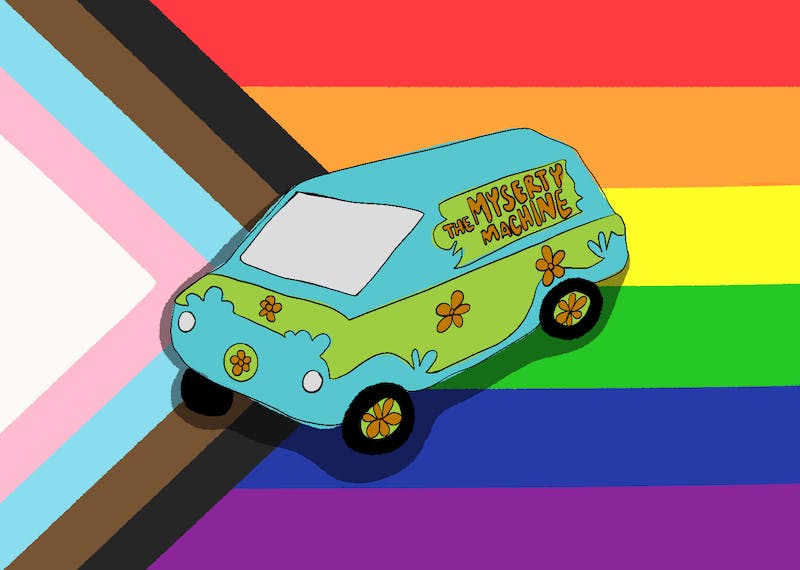
Creators do their best to work within the constraints of a highly commercial entertainment industry, where decisions are made based on projected financial gain. Queer coding, or the practice of suggesting a character is queer without explicitly stating it, is one method creators have used to cut through the red tape.
This is not to be confused with queerbaiting, the practice of purposely teasing queer romances or characters, without ever confirming to audiences. Queerbaiting is widely considered by the LGBTQ+ community to be the unethical and financially driven sibling of benign queer coding.
“I think it’s pretty cowardly,” said Ohia Aster, a sophomore studying information technology. As an officer of the Rainbow Coalition, they have ample experience viewing queer coding in media. “You’re giving yourself kind of a door out in case it ever becomes controversial, which it shouldn’t be in the first place.”
Just as the LGBTQ+ community is full of diversity, so are its perspectives. Even so, most agree on the need for continual improvement. The general consensus is this: Even with how far we have moved toward acceptance and representation in media, there is still a long way to go.
“Especially nowadays, I don’t really see coding put in a bad light,” said Joshua Valenzuela, a fellow Rainbow Coalition officer, and senior studying politics and the economy. Writers, he said, “are pushing the envelope” with the increasing boldness with which queerness is expressed in fictional characters.
The LGBTQ+ community and animation lovers everywhere have cause to celebrate a move forward. Velma Dinkley was confirmed in a clip from the trailer for “Trick or Treat Scooby-Doo!,” released Oct. 4, to be part of the queer community.
Though many have suspected over the years due to the queer coding, the beloved “Scooby-Doo” character was finally confirmed a member of the LGBTQ+ community.
This is the 45th film of the “Scooby-Doo” franchise. Despite little advertising, fans had reason to be excited prior to the film’s release about Velma’s character and the return of a classic voice. Matthew Lillard, who played Shaggy in the 2002 live-action film, reprised his role in this version as a voice actor. After release, the film garnered a Rotten Tomatoes audience score of 44%.
Yihwa, a senior studying biochemistry who requested to remain partially anonymous to protect her privacy, has her own bone to pick with queer animation, specifically what she refers to as “queer struggle,” or one-off queer characters existing solely to represent the struggles of all queer life.
“When it’s only struggle … that we’re written for, it’s kind of disheartening to see in the media,” Yihwa said. Yihwa praised Disney’s “The Owl House” for overcoming this tendency with its portrayal of canon queer relationships.
Those involved in previous iterations of the franchise have hinted at Velma’s sexuality for years. Writer James Gunn confirmed he wrote Velma as explicitly gay in his original script for the 2002 live-action film, reportedly even filming a kiss scene between her and Daphne Blake. Gunn blames the studio, Warner Bros., for the watered-down final cut that hit the big screen.
Tony Cervone, co-creator of the 2010 animated series that aired on Cartoon Network, went so far as to post a picture of Velma in front of a pride flag backdrop on Instagram in 2020.
Valenzuela, the Rainbow Coalition officer lamented the lack of male representation in queer fiction. “There’s been great progress for queer representation, but it’s very heavily skewed towards representing queer women over queer men.”
Austin Graham-O’Hara, a junior in Spanish linguistics and microbiology and an officer of Qmunity at ASU, an LGBTQ+ club, praises queer fiction in general for its influence on his own life.
“I definitely remember visual media as playing a huge role in my own coming out,” O’Hara said. “There’s no one right way to be queer, and it showcases that diversity.”
Kit Eaton, a senior majoring in sociology and global health, and another Qmunity officer, praises the “Scream” television series, specifically the queer character, Audrey. “She helped me realize I was queer,” said Eaton. “Her … journey taught me how to describe it.”
They also praise the character A-spen from the film “Zombies 3,” one of the first non-binary Disney characters, and who is played by a non-binary actor. “(They) have taught me a lot about myself and who I want to become.”
Still, Eaton expressed their hopes for more inclusivity in the future of queer media. “Hopefully, we get to a place where queerness isn’t an afterthought.”
Edited by Claire van Doren, Wyatt Myskow, Sophia Balasubramanian, Kate Ourada and Piper Hansen.
Reach the reporter at myarmst2@asu.edu.
Like The State Press on Facebook and follow @statepress on Twitter.







